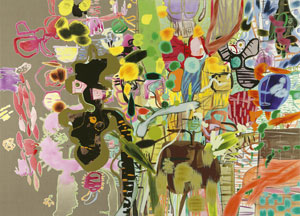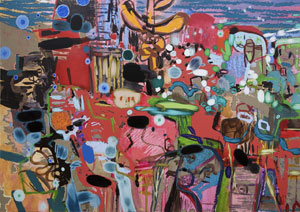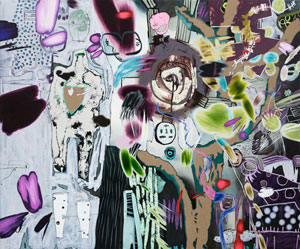Dan Perfect’s Paintings and Drawings at Road Agent Gallery does not so much revitalize high modernism as cast it in an awfully hip light. The doodles, squiggles and jig-dancing zoography of Joan Miro and Pablo Picasso are, alas, avant-garde in ways previously unforeseen. They become renegade forecasters of 21st century graphic design, so many harbingers of Tim Biskup, SHAG (aka Josh Agle), Brandon Steen and a spate of telegenic creatures, such as Sponge Bob Square Pants, Chowder and Cow and Chicken. In an acrobatics of time, Perfect uses his own work to lay bare this other future of yesterday’s art. He articulates the unconscious of the unconscious, exposing the frivolous, kitschy underside of that modernist holy grail otherwise known as authentic Jungian probing.
Perfect elides high modern technique and gives us contemporary drawn and painted high jinks. Once innovative breakthroughs and always energetic, gesture and chance are the staples of Perfect’s process. The range of activity on the surface of his painting Easter – swirls, deformed phalluses, smudges and an aerial grid of farmland – describes an artist at work, his mind racing and hands trying to cope. Viewers’ eyes scan from left to right over a raw dun-colored canvas that gives way to pink elongated lozenges, darker pink entrails. Black marks are scrawled atop seemingly unhurried rounded yellow marks. The center contains a squirrely grid of landscape, rendered as if seen from the air and through a happy, hallucinogenic fog.
Graffiti thunders across this plane of action in more ways than one – as both form and act. As a grammar of form, the shapes seem inspired by graffiti; hapless, accidental and of the street. In leaving the canvas brown and unprimed, Perfect performs acts of graffiti on proverbial Painting. Though truly a ledger recording thoughtful processes and months of work, the paintings in finished form conjure images of Perfect as artist-terrorist skulking about a room of blank, unprimed canvases. He starts at midnight, leaves his layers of marks, and before dawn can strike is on the run to the next scene of painting crimes and misdemeanors.
Several drawings, in watercolor, ink and pastel, bring home a similar sense of frenetic information in a smaller, more delicate scale (9 x 12 inches). At the center of the very Picasso-esque work Spleen there grimaces a large, hydrocephalic head floating amid curvilinear abstract forms. Night Crusher shows a black pastel creature with finger-like quills protruding from the chubby lines of his robotic body. The at once playful and menacing figure shown in a maelstrom of marks refers to the condition clinically known as “sleep paralysis.” Made most visually famous by Henry Fuseli’s The Nightmare (1781), sleep paralysis, also known as the “night fright” and “night crusher,” is the sensation of being awoken by a wraithlike presence in the room – a ghost that seems all too real, especially because you cannot move.
Prima facie (or perhaps “prima sentie”), the works, especially the four luscious, large paintings, might be faulted for just being pretty things. One might criticize them because their strength lies in their intuitive nature, the feelings they elicit, or in their sheer beauty and experiential quality, rather than in anything too cerebral. The large paintings are great to look at and fantastic to stand next to, but seem at first to be just that – attractive paintings; no more, no less. Such a criticism would of course come from those who want more than touchy-feely formalism, i.e. works that go with the couch.
But such criticism would give short shrift to Perfect, the artist and his work. It would underestimate the way that Perfect plays with “intuition” in this work. For Perfect, intuition is not something that wells up from the core of the body, but is something that comes from the snap of a finger, the surface of the mirror and the thinking-craziness of Attention Deficit Disorder. The source of intuition is split-second and accidental, rather than any such profound, ruminating and enlightened individualism.
In mixing Surrealist chance, AbEx gesture and contemporary cartoonish graphics, Perfect casts intuition, contemplation and Jungian probing in a critical light. By denying the deep probing power of the painterly gesture, he performs what Warhol did in 1962 with the first silkscreened Marilyns. Perfect deconstructs the once hallowed and serious role modern painting played in unpacking the psyche. Calling on the ideas of Freud, Surrealists believed painting had the power to disinter the raw, profound you by getting at the unconscious (or God forbid, the id) at the root of the ego. AbEx-ers similarly looked to painting as a means to solicit, locate and truth be told, invent the Jungian archetypes. Even more powerfully, Perfect deconstructs the human mind’s very ability to have so much depth and so many layers. For Perfect, chance and gesture become waylayers of the white noise of the surface. These paintings tell us that attempting to disinter anything will only leave you with a broken pickaxe and a severe case of tendonitis.
There is a lot of looking to be had in this small rich exhibition of work by Perfect. No mere dabbler, Perfect perfects the surfaces of his paintings using painterly ways more graphic than those of yesterday’s maestros of surface. Viewers be aware: One painting at a time.
Dan Perfect: Paintings & Drawings
Road Agent Gallery
October 24-December 6

Charissa N. Terranova is the Assistant Professor of Aesthetic Studies
at UTD and the director of Centraltrak, the UTD Artists Residency Program.
Also by Charissa N. Terranova:
{ Review }
"Hubbard/Birchler: No Room To Answer" at The Modern
{ Review }
"Sehnsucht (Aspiration)" at Light & Sie
{ Feature }
Punkish and Puckish: An Interview with Tim Noble and Sue Webster
{ Feature }
Arthouse Renovation
{ Feature }
Becoming-Animal: Rebecca Carter, A Hybrid Approach to Art as Life
{ Interview }
Tracey Emin is a woman’s woman







